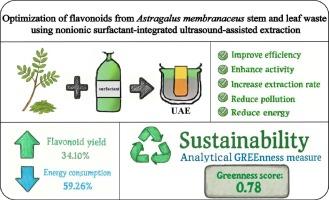Optimization of flavonoids from Astragalus membranaceus stem and leaf waste using nonionic surfactant-integrated ultrasound-assisted extraction
IF 9.7
1区 化学
Q1 ACOUSTICS
引用次数: 0
Abstract
This study aimed to optimize the extraction of flavonoids from the stem and leaf waste of Astragalus membranaceus (AMW) using nonionic surfactant-integrated ultrasound-assisted extraction (UAE). Genapol X-080 was identified as the most effective surfactant for flavonoid extraction. UAE outperformed both stirring-assisted and heating methods in terms of yield. A sustainability analysis showed that UAE with nonionic surfactants was environmentally favorable, scoring 0.78 in the Analytical Greenness Calculator. The extraction process was optimized using Response Surface Methodology (RSM), starting with a Plackett-Burman Design (PBD) to identify important factors, such as liquid–solid ratio, ultrasonic time, temperature, ethanol concentration, and ultrasonic power. The optimized conditions were 55 min of ultrasonic time, 50 °C, 70 % ethanol, and 100 W ultrasonic power. Under these conditions, the UAE method increased flavonoid yield by 25.60 % while reducing energy consumption by 59.26 %. The optimized extracts demonstrated superior antioxidant activity in DPPH, ABTS, FRAP, and hydroxyl radical scavenging assays. These findings highlight the potential of AMW as a sustainable source of bioactive flavonoids and contribute to the valorization of plant biomass waste. Future work will investigate the underlying extraction mechanisms and explore the broader applicability of this technique for the efficient and sustainable extraction of bioactive compounds from various biomass resources.

非离子表面活性剂联合超声辅助提取黄芪茎叶废黄酮的工艺优化。
以黄芪(Astragalus membraneaceus, AMW)茎叶废液为原料,研究非离子表面活性剂-超声辅助提取黄酮类化合物的工艺条件。Genapol X-080是提取黄酮类化合物最有效的表面活性剂。阿联酋在产量方面优于搅拌辅助和加热方法。可持续性分析表明,使用非离子表面活性剂的阿联酋对环境有利,在分析绿色计算器中得分为0.78。采用响应面法(RSM)优化提取工艺,从Plackett-Burman设计(PBD)入手,确定液料比、超声时间、温度、乙醇浓度和超声功率等重要因素。优化条件为超声时间55 min,超声温度50℃,乙醇含量70%,超声功率100 W。在此条件下,UAE法黄酮得率提高25.60%,能耗降低59.26%。优化后的提取物在DPPH、ABTS、FRAP和羟基自由基清除实验中显示出优越的抗氧化活性。这些发现突出了AMW作为生物活性类黄酮的可持续来源的潜力,并有助于植物生物质废物的增值。未来的工作将研究潜在的提取机制,并探索该技术在有效和可持续地从各种生物质资源中提取生物活性化合物方面的更广泛适用性。
本文章由计算机程序翻译,如有差异,请以英文原文为准。
求助全文
约1分钟内获得全文
求助全文
来源期刊

Ultrasonics Sonochemistry
化学-化学综合
CiteScore
15.80
自引率
11.90%
发文量
361
审稿时长
59 days
期刊介绍:
Ultrasonics Sonochemistry stands as a premier international journal dedicated to the publication of high-quality research articles primarily focusing on chemical reactions and reactors induced by ultrasonic waves, known as sonochemistry. Beyond chemical reactions, the journal also welcomes contributions related to cavitation-induced events and processing, including sonoluminescence, and the transformation of materials on chemical, physical, and biological levels.
Since its inception in 1994, Ultrasonics Sonochemistry has consistently maintained a top ranking in the "Acoustics" category, reflecting its esteemed reputation in the field. The journal publishes exceptional papers covering various areas of ultrasonics and sonochemistry. Its contributions are highly regarded by both academia and industry stakeholders, demonstrating its relevance and impact in advancing research and innovation.
 求助内容:
求助内容: 应助结果提醒方式:
应助结果提醒方式:


